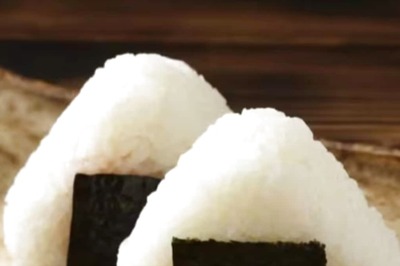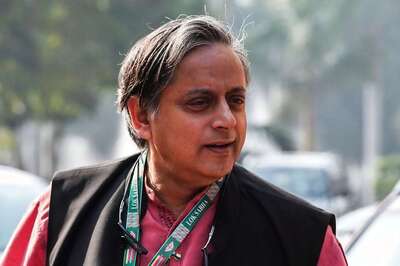
views
Sendai: Japan fought on Sunday to avert a meltdown at two earthquake-crippled nuclear reactors, describing the massive quake and tsunami, which may have killed more than 10,000 people, as the nation's biggest crisis since World War Two.
The world's third-largest economy is struggling to respond to a disaster of epic proportions, with more than 1 million without water or power and whole towns wiped off the map.
"The earthquake, tsunami and the nuclear incident have been the biggest crisis Japan encountered in the 65 years since the end of World War II," a grim-faced Prime Minister Naoto Kan told a news conference.
"We're under scrutiny on whether we, the Japanese people, can overcome this crisis."
As he spoke, officials worked desperately to stop fuel rods in the damaged reactors from overheating, which could in turn melt the container that houses the core, or even explode, releasing radioactive material into the wind.
The government said a building housing a second reactor at the same complex was at risk of exploding after a blast blew the roof off the first the day before. The complex is 240 km (150 miles) north of Tokyo.
Broadcaster NHK, quoting a police official, said more than 10,000 people may have been killed as the wall of water triggered by Friday's 8.9-magnitude quake surged across the coastline, reducing whole towns to rubble.
Officials worked desperately to prevent the fuel rods in the damaged plants from overheating after radiation leaked into the air. The government said a building housing a second reactor was at risk of exploding after a blast blew the roof off a different plant the day before.
The nuclear accident, the worst since the Chernobyl disaster in 1986, sparked stinging criticism that authorities were ill-prepared for such a massive quake and the threat that could pose to the country's nuclear power industry.
Thousands were evacuated on Saturday following the explosion and leak from the facility's No. 1 reactor in Fukushima, 240 km (150 miles) north of Tokyo, where there is believed to have been a partial meltdown of the fuel rods.
Engineers were pumping in seawater, trying to prevent the same happening at the No. 3 reactor, the government said in apparent acknowledgement it had moved too slowly on Saturday.
"Unlike the No.1 reactor, we ventilated and injected water at an early stage," Chief Cabinet Secretary Yukio Edano told a news briefing.
Asked if fuel rods were partially melting in the No. 1 reactor, Edano said: "There is that possibility. We cannot confirm this because it is in the reactor. But we are dealing with it under that assumption ."
He said fuel rods may have partially deformed at the No. 3 reactor but a meltdown was unlikely to have occurred.
"The use of seawater means they have run out of options," said David Lochbaum, director of the Union of Concerned Scientists Nuclear Safety Project.
"If they had any other water they would have used it. It likely means the power for their pumps is gone."
Nuclear plant operator Tokyo Electric Power (TEPCO) said radiation levels around the Fukushima Daiichi plant had risen above the safety limit but that it did not mean an "immediate threat" to human health.
Edano said there was a risk of an explosion at the building housing the No. 3 reactor, but that it was unlikely to affect the reactor core container.
The government said it planned electricity blackouts in areas covered by TEPCO lasting a few weeks.
The disaster prompted an angry response from an anti-nuclear energy NGO in Japan which said it should have been foreseen.
"A nuclear disaster which the promoters of nuclear power in Japan said wouldn't happen is in progress," the Citizens' Nuclear Information Centre said. "It is occurring as a result of an earthquake that they said would not happen."
Thousands spent another freezing night huddled in blankets over heaters in emergency shelters along the northeastern coast, a scene of devastation after the quake sent a 10-metre (33-foot) wave surging through towns and cities in the Miyagi region, including its main coastal city of Sendai.
In one of the heavily hit areas, Rikuzentakata, a city close to the coast, more than 1,000 people took refuge in a school high on a hill. Some were talking with friends and family around a stove. The radio was giving updates. On the walls were posters where names of survivors at the shelter were listed.
Some were standing in front of the lists, weeping.
Kyodo news agency reported there had been no contact with around 10,000 people in one town, more than half its population.
A Japanese official said there were 190 people within a 10-km radius of the nuclear plant when radiation levels rose and 22 people have been confirmed to have suffered contamination. Workers in protective clothing were scanning people arriving at evacuation centres for radioactive exposure.
The crisis has triggered anti-nuclear power protests in Europe. Up to 60,000 protesters formed a 45-km (27-mile) human chain in Germany to denounce the government's policy of extending the life of nuclear plants.
Officials in Japan ordered the evacuation of a 20-km (12-mile) radius zone around the nuclear plant and 10 km (6 miles) around another nuclear facility close by.
Around 140,000 people had left the area, while authorities prepared to distribute iodine to protect people from radioactive exposure.
"There is radiation leaking out, and since the possibility (of being exposed) is high, it's quite scary," said Masanori Ono, 17, standing in line on Saturday to be scanned for radiation at an evacuation centre in Fukushima prefecture.
The wind over the plant would continue blowing from the south, which could affect residents north of the facility, an official at Japan's Meteorological Agency said.
The government, in power less than two years and which had already been struggling to push policy through a deeply divided parliament, came under criticism for its handling of the crisis.
"Crisis management is incoherent," blared a headline in the Asahi newspaper, charging that information disclosure and instructions to expand the evacuation area around the troubled plant were too slow.
"Every time they repeated 'stay calm' without giving concrete data, anxiety increased," it quoted an unidentified veteran party lawmaker as saying.
There have been proposal of an extra budget to help pay for huge cost of recovery but the government says there is also a 200 billion yen ($2.4 billion) budget reserve for the current fiscal year which can be used.
The Bank of Japan is expected to pledge on Monday to supply as much money as needed to prevent the disaster from destabilising markets and its banking system. It is also expected to signal its readiness to ease monetary policy further if the damage from the worst quake since records began 140 years ago threatens a fragile economic recovery.
Before news of the problem with reactor No. 3, the UN nuclear safety agency said the plant accident was less serious than both the Three Mile Island accident in 1979 and Chernobyl in 1986.
An official at the agency said it rated the incident a 4 according to the International Nuclear and Radiological Event Scale (INES). Three Mile Island was rated 5 while Chernobyl was rated 7 on the 1 to 7 scale.
Along the northeast coast, rescue workers searched through the rubble of destroyed buildings, cars and boats, looking for survivors in hardest-hit areas such as Sendai, 300 km (180 miles) northeast of Tokyo.
Aerial footage showed buildings, trains and even light aircraft strewn like children's toys after powerful walls of seawater swamped areas around Sendai.
Kyodo said about 300,000 people were evacuated nationwide, many seeking refuge in shelters, wrapped in blankets, some clutching each other sobbing.
It said 5.5 million people were without power, while 20,800 buildings had been destroyed or damaged. Four trains were unaccounted for after the tsunami.
TEPCO has had a rocky past in an industry plagued by scandal. In 2002, the president of the country's largest power utility was forced to resign along with four other senior executives, taking responsibility for suspected falsification of nuclear plant safety records.
Many Japanese flooded social networking sites with worries about the plant.
"I can't trust TEPCO," said a person with the handlename Tanuki Atsushi on mixi, the Japanese social networking site.
Foreign countries have started to send disaster relief teams to help Japan, with the United Nations sending a group to help coordinate work.
The earthquake was the fifth most powerful to hit the world in the past century. It surpassed the Great Kanto quake of Sept. 1, 1923, which had a magnitude of 7.9 and killed more than 140,000 people in the Tokyo area.
Media said it was 8,000 times more powerful than the quake which devastated the New Zealand city of Christchurch last month.



















Comments
0 comment